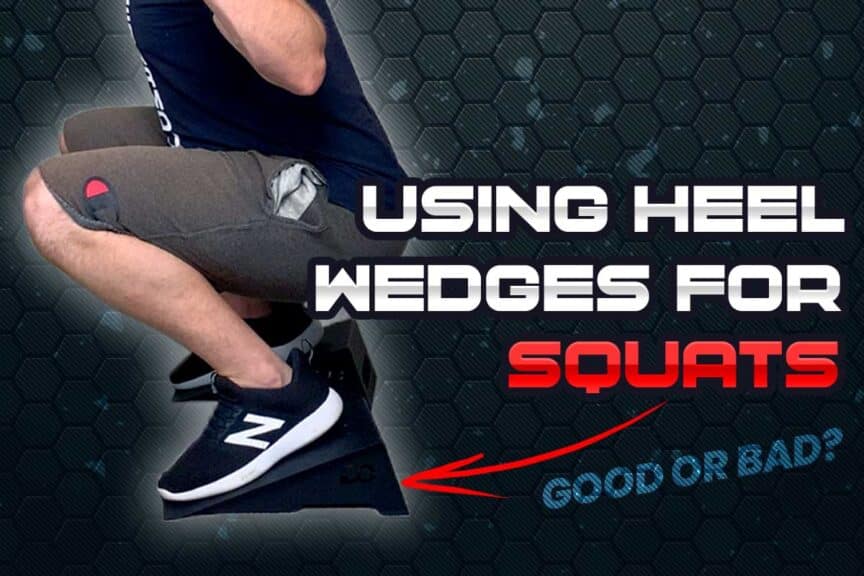If you’ve ever seen others in the gym squatting with their heels or feet resting on a slanted surface or even standing with their heels on top of some small weight plates, there can be multiple reasons as to why. This article will provide some really cool insight into what this heel-elevated squatting can be used for, as well as some other factors to consider when opting for this squatting modification.
Benefits of squat wedges (or a slant board) can include:
- Improved squat depth.
- Increased lower back safety.
- Pain avoidance.
- Greater activation of the quadriceps muscles.
Drawbacks can include:
- Increased strain on the knees
- Enabling reduced mobility of the ankles and calves.
It’s neither right nor wrong to use implements such as squat wedges or a slant board; like any other tool, these items have a time and place for their use based on the needs or goals of the lifter. So, if you want to know their unique benefits and their potential drawbacks, keep reading!
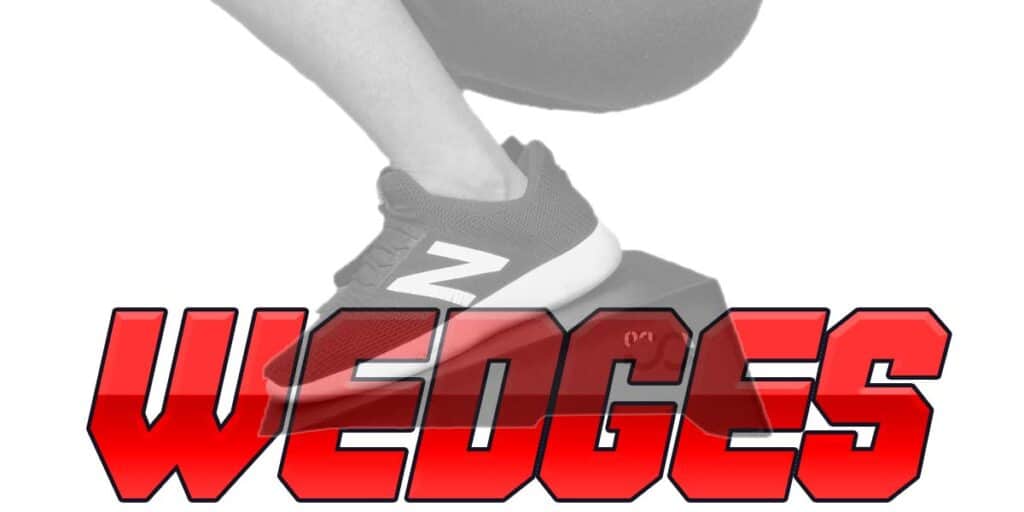
Terminology: A quick note
As we dive into this article, be aware that you may hear various terms for this sort of squat or squatting technique; slant boards, slant board squats, heel lifts, squat wedges, heel-raised squats, etc., tend to all mean the exact same thing. So, keep that in mind in case you’re hearing some slightly different terminology about this topic either online or in the gym.
The only notable difference to point out is that squat wedges refer to a pair of angled wedges (one for each foot), whereas a slant board is a single unit designed for both feet to be placed on the same surface (though you can, of course, still place a single foot on the board if you’d like).
Now, whether you choose to use wedges or a single board, the benefits and potential drawbacks that follow apply to both just the same.
Benefit 1: Low back safety & squat depth
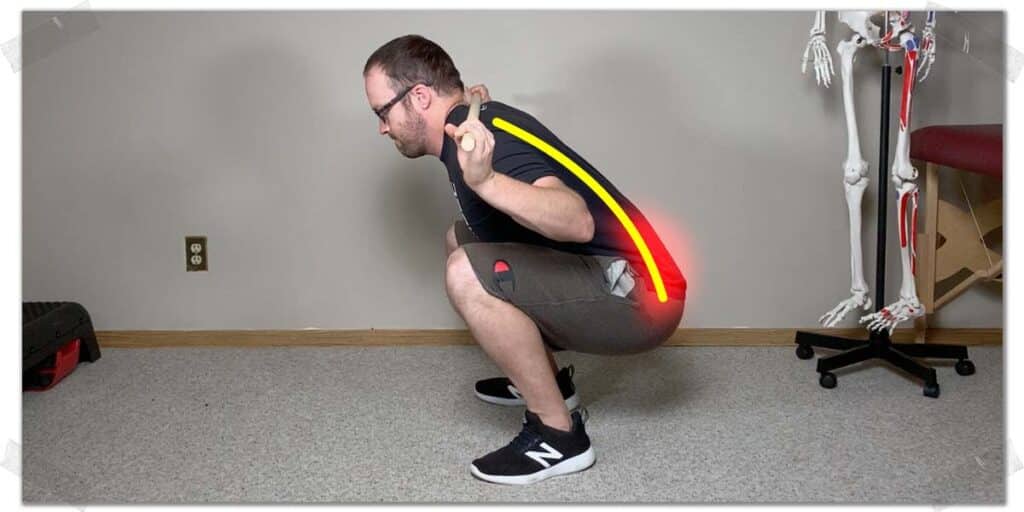
Arguably, the most common reason for squat wedges and slant boards to be used for squatting is to improve the range of motion in the squat (with a subsequent massive safety benefit to the lower back). Both of these benefits truly go hand-in-hand, so I’m placing them into the same benefit within this article.
Let’s look at each in a bit more detail.
Improving squat depth
The squat depth an individual can adequately (and safely) achieve is inherently linked to the overall mobility of their muscles, tendons, and joints. With everything in the body essentially being linked, decreased mobility in one area of the body (the lower body, in particular) can reduce overall squat performance and range of motion.
Common areas of inadequate mobility that adversely affect squat depth include:
- The ankle joint (the talocrural joint)
- The calves, soleus & Achilles tendon (known as the triceps surae)
- The upper hamstrings
- The hip joint and hip capsule
- The lower back muscles (erector spinae)
- The lumbar spine (vertebrae)
The intricate connection of muscles, tendons, and ligaments on the backside of the body that work together to help produce various physical movements is known as the posterior chain.
The posterior chain is essentially slackened by placing the ankles in a downward position (known as ankle plantarflexion) when standing on a squat wedge or slant board, resulting in greater available range of motion from the body before the squat pattern must be altered (known as movement compensation).
This “slackening” means, of course, that there is more available range of motion for the body to utilize when it comes to dropping deeper into the squat. Deeper squats can be beneficial for numerous reasons ranging from improved muscle activation to increased performance. However, deep squats are not all that beneficial if movement compensation must occur. To find out why, read the section below.
Improving lower back safety
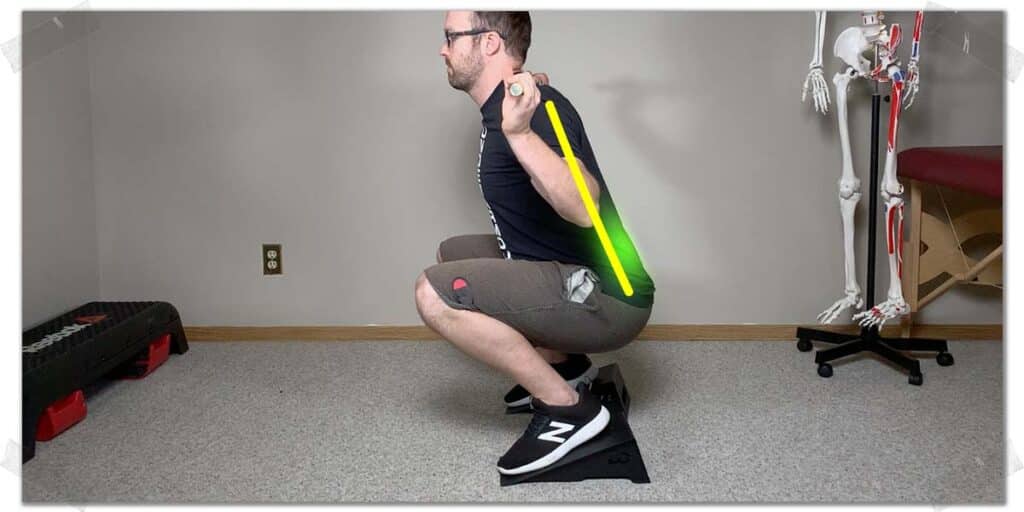
When the hips or the posterior chain no longer has any available range of motion left during the downward phase of the squat, the body must find a way to compensate for the remaining portion of the squat if squat depth continues to increase.
Whether the body has run out of available range of motion due to inadequate hip joint mobility, lousy ankle dorsiflexion mobility, calf or hamstring mobility, the joints of the lower back will be the first to compensate to help make up for range of motion (and thus, increased squat depth) by moving into a rounded position (known as lumbar flexion).
Lumbar flexion during a loaded squat can be detrimental to the health of the joints and discs of the lumbar spine. This unwanted flexion at the bottom of the squat is often termed “butt wink.” It should be avoided anytime you’re squatting against an external resistance (back squats, front squats, goblet squats, etc.).
Related article: Back Pain From Box Squats | Causes | Fixes | Expert Tips (Full Guide)
When using squat wedges or a slant board, the body can maintain a neutral (straight) lumbar spine extension throughout all (or, at least, most) of the squat. The result is a lower back that isn’t exposed to lousy positions and subsequent forces that can lead to various causes of lower back pain.
So, if you know you’ve got some butt-wink going on at the bottom of your squats and want to keep on squatting (while you work on fixing the underlying causes, of course), using squat wedges or a slant board could be a smart move to make!
Benefit 2: Greater quadriceps activation
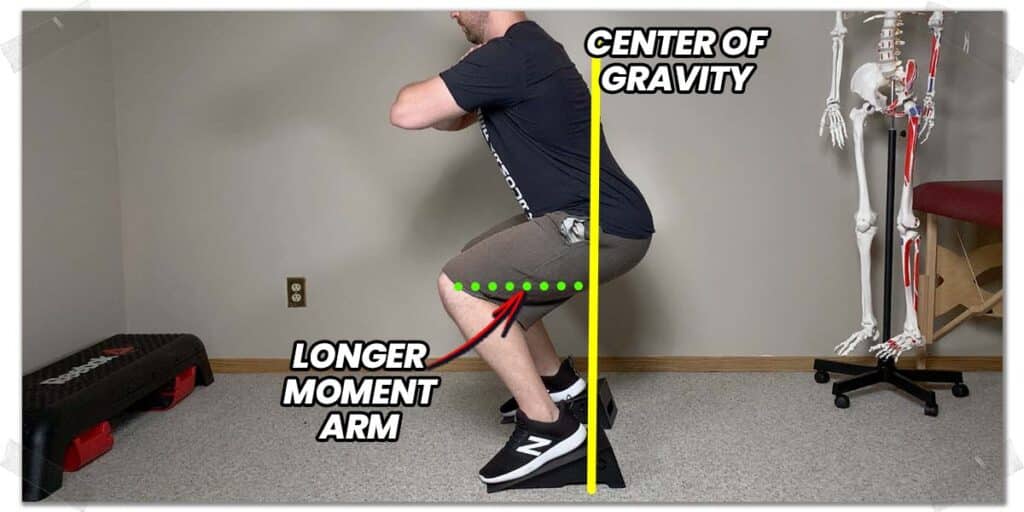
Another rather sweet benefit of squat wedges and slant boards is their ability to alter the demands of how aggressively certain muscle groups must work when squatting. More specifically, squatting with the heels elevated results in greater recruitment of muscle fibers from the quadriceps muscles, which can be used to the benefit of the lifter based on their needs or goals.
The biomechanics of how this precisely happens is far beyond the scope of this article; however, here is the key concept you can research more in-depth if you’re interested in the specifics:
- Squat wedges will slightly modify the squatter’s center of gravity by moving it backwards. This, in turn, creates a longer moment arm from the axis of rotation around the knee (since the torso now stays more upright during the squat), which forces the distal portion (closer to the knee) of the quadriceps to contract more aggressively. As a result, the greater the angle of the wedge, the more the squatter’s center of gravity is shifted backwards (and thus, the greater extent of quadriceps activation).
Related article: Spanish Squats for Patellar Tendinopathy: How | Why | When (Must Know)
As a result, bodybuilders and other physique competitors will take advantage of this phenomenon when looking to target their quads to a greater extent during their training, resulting in improved muscle mass, definition, etc.
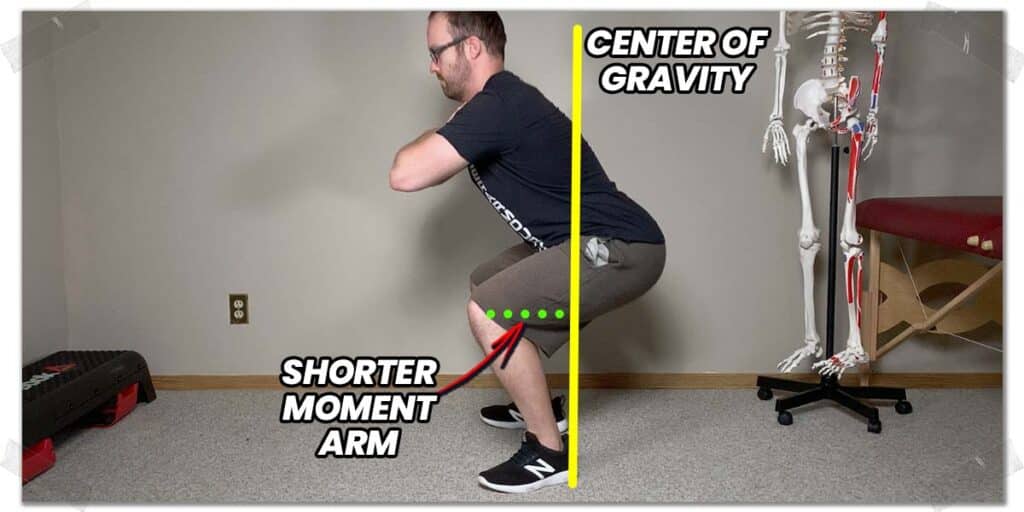
This phenomenon is also often taken advantage of in the world of physical rehabilitation (typically in later stages) when looking to rehabilitate various types of knee and quadriceps injuries, such as patellar tendinopathy and quadriceps tendinopathy.
Benefit 3: Offloading painful tissues
As mentioned in benefit 1, wedges and slant boards help slacken the posterior chain, making them ideal for those with inadequate mobility anywhere from their ankles, hips, lower back, and anywhere else along the chain.
However, sometimes it’s not as much about using wedges and boards to work around lousy or restricted mobility as it is to avoid pain or discomfort as tissues lengthen out.
Various orthopedic conditions in the lower body can lead to discomfort or pain when specific muscles or tendons are placed into a lengthened state (stretched out). Such conditions can include (but are not limited to):
- Plantar fasciitis
- Achilles tendonitis/tendinosis
- Tibialis posterior tendonitis/tendinopathy
- Muscle strains of the gastrocnemius (calf) or soleus muscle
Related article: The Seven Best Ways to Massage Your Calf Muscles All By Yourself
Squats of any type will place these affected tissues into a lengthened state, which can lead to discomfort or pain. If this pain or discomfort limits or prevents your ability to squat, using wedges or a board to avoid stretching the sensitive tissue(s) can often permit you to continue squatting by avoiding this issue in the process.
Generally speaking, the greater the angle of dorsiflexion the ankle is kept at during the squat (i.e., the greater the angle of the wedge or board you stand on), the more significant the reduction in stretch to the muscles and tendons that cross the ankle and the lower back.
Drawback 1: A crutch to improving mobility
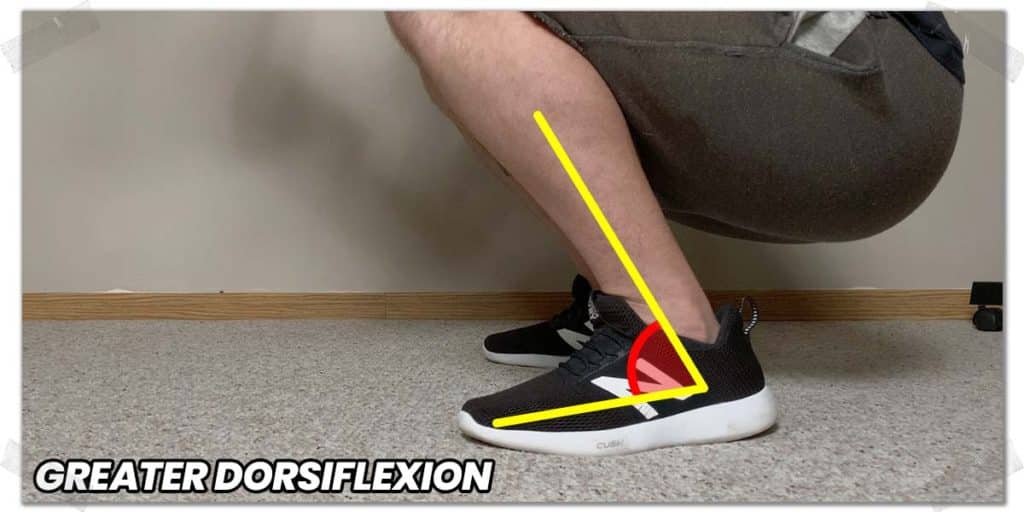
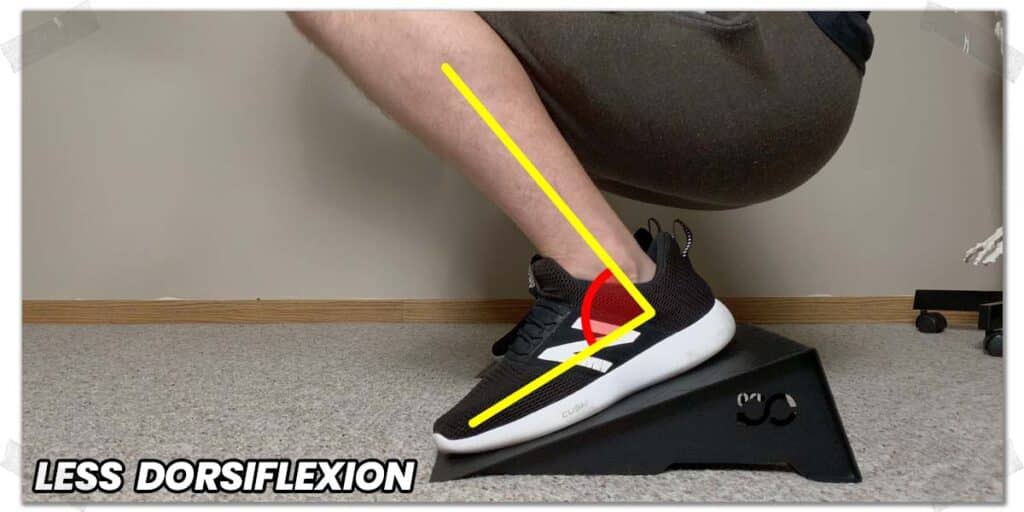
While there are plenty of advantages to using squat wedges and slant boards, there can also be drawbacks to consider as well (just like with any other piece of fitness equipment that exists).
If your overall squat mobility isn’t where you want or need it to be, wedges and boards can help you train around the issue, but they certainly won’t fix the underlying cause.
I’ve often seen various lifters (knowingly or unknowingly) use squat wedges as a crutch for their training, as opposed to an adjunct that allows them to keep squatting while simultaneously taking action to improve their limited mobility.
If you’re looking at using wedges with your squats because your mobility or flexibility is inadequate, make sure that you take time within your training regimen to identify and address the underlying cause(s) of why your mobility and squat range is poor.
Related article: Four Handy Exercises to Help Loosen Stiff Ankles in All Directions
As a general recommendation, I’d consider starting by looking at the following body parts:
- Ankle mobility, especially with ankle dorsiflexion
- Hip mobility, particularly with hip flexion
- Thoracic mobility, particularly with thoracic extension
Drawback 2: Increased stress on the knees
As mentioned with benefit 2, squatting with wedges or a board underneath your heels will force the quadriceps to work more so than when squatting with your feet flat on the ground. It’s a potent benefit, to be sure; however, for some individuals’ knees, it can be a bit too much.
Depending on one’s health of their knee joint(s) and their tendons (which cross over the joint), the additional muscle activation and subsequent force that runs through the knees can be irritating or even painful.
Additionally, if the quadriceps muscles are a bit stiff or otherwise inflexible (which, as physical therapists, we call hypomobile), the added force now running through the muscles or tendons can make for a lousy (or even painful) squatting experience.
In my personal experience, this tends to only happen with either extreme wedge angles, heavy resistance loads, or rather unhealthy knees (or some combination of the three).
Nonetheless, if you know that one or both of your knees aren’t currently in the greatest overall condition, being mindful of your wedge angle or the extent to which you use some form of a heel lift is worth keeping in mind.
Pro tip: If your knees or quadriceps are susceptible to feeling a bit stiff or tight before regular squats, be sure to give them an extra thorough warmup before hopping into your working sets of heel-elevated squats.
Wedges: What’s the ideal angle?
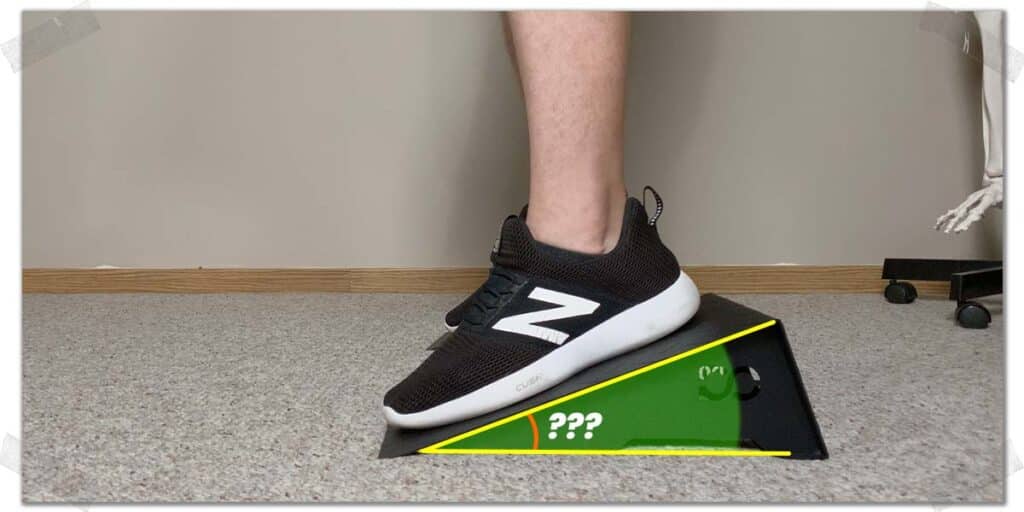
So, we’ve now gone through the benefits and drawbacks of squatting while elevating your heels on some type of angled surface. However, it’s also a good idea to briefly discuss how much of an angle your wedge or slant board should be when considering squatting with them.
There’s no universal rule for the absolute best or most ideal angle when using wedges or a slant board. That being said, an angle that is too small might not produce beneficial changes to your squat pattern or quadriceps activation. At the same time, an angle that’s too extreme may cause you to lose your footing or balance entirely.
The good news here is that with wedges and certain boards, you can easily increase or decrease the angle by how much or little of your foot you place on the angled surface.
- To decrease the angle: keep more of your forefoot on the flat ground.
- To increase the angle: keep more of your forefoot on the slanted surface.
In my experience, an angle of around twenty degrees is rather sufficient for improving squat depth without sacrificing balance or overloading the knees and quadriceps. There’s no harm in using more or less of an angle; you’ll just need to determine what’s best for your needs.
Pro tip: Slant boards are often adjustable, allowing for multiple angles based on your needs or preferences. This is one of the unique benefits they often hold over individual wedges.
Personally, I’d advocate that you use as little angle as required to produce the effects you’re after (perfect squat form, avoiding discomfort in your foot or calves, etc.). Think of it as the minimal effective dose required to achieve the effects you’re after.
Final thoughts
Like anything else, wedges and slant boards have a time and place for their use. Reasons for their use can vary greatly, ranging from safety to altered muscular activity and even injury rehabilitation.
If you’re considering propping your heels on some type of elevated surface for your squats, there are plenty of reasons to do so and plenty of benefits to be had. Just make sure you’re aware of the potential drawbacks that can also creep into the scenario.
Happy squatting!

Hi! I’m Jim Wittstrom, PT, DPT, CSCS, Pn1.
I am a physical therapist who is passionate about all things pertaining to strength & conditioning, human movement, injury prevention and rehabilitation. I created StrengthResurgence.com in order to help others become stronger and healthier. I also love helping aspiring students and therapists fulfill their dreams of becoming successful in school and within their clinical PT practice. Thanks for checking out my site!

